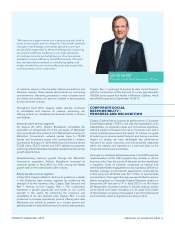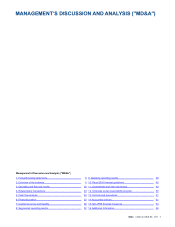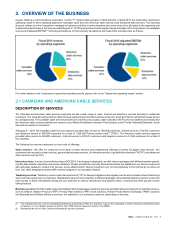Cogeco 2015 Annual Report Download - page 16
Download and view the complete annual report
Please find page 16 of the 2015 Cogeco annual report below. You can navigate through the pages in the report by either clicking on the pages listed below, or by using the keyword search tool below to find specific information within the annual report.MD&A COGECO CABLE INC. 2015 15
IMPROVING THE NETWORKS WITH STATE OF THE ART ADVANCED TECHNOLOGIES
We operate in an industry characterized by rapid technological innovation which will continue to require capital for the upgrade, expansion and
maintenance of our network and the launch and expansion of new or additional services.
CANADIAN CABLE SERVICES SEGMENT
Progress in fiscal 2015
During the fiscal year ended August 31, 2015, our Canadian cable services segment invested $237.0 million mainly to increase its scalable
infrastructure, extend and improve network capacity, launch its TiVo video platform and deploy advanced technologies.
Cogeco Cable Canada completed in fiscal 2015 the initial phase of the conversion to Switched Digital Video (“SDV”) technology and additional
HD channels in Québec and started their implementation in August. This technology allows Cogeco Cable Canada to selectively broadcast the
digital channels that are currently being viewed by customers, effectively allowing it to offer a greater selection of digital channels over the same
network infrastructure.
We deployed public WiFi access networks in Burlington, Oakville, Hamilton, Milton, St. Catherines, Niagara, Windsor, Kingston, and downtown
Trois-Rivières, including the migration to the next generation WiFi management platform. We are now offering to more than 1,600 access points
in almost 50 Ontario communities including the Golden Horseshoe as the biggest WiFi network.
Moreover, we started in fiscal 2015 the replacement of the aging VOD platform. The new management Systems and the upgraded Content
Delivery Network (“CDN”) initiative for Ontario and Québec are at the implementation phase.
We continued to extend the DOCSIS 3.0 technology, which allows us to provide faster Internet speeds with packages currently up to 250 Mbps
in Canada, increasing our coverage to 97% of homes passed. For business customers, we continued to improve our Internet speeds, having
some of the fastest speeds versus the competition. To further improve our competitive stance, we introduced new Internet bundled pricing leading
to an increase in multi-product business customers.
During fiscal 2015, Cogeco Cable Canada continued the deployment of FTTH systems using the RFoG technology in all new residential
developments which meet specific criteria of size, proximity to the existing plant and service penetration rate. RFoG offers increased reliability,
lower maintenance costs and is an excellent platform for the delivery of enhanced video services and higher speed internet services in the future.
We also completed the Metaswitch migration for business telephony services such as Hosted PBX and SIP Trunking are now available for small
and medium business customers since May 2015 in Québec.
Focus in fiscal 2016
We will continue developing our WiFi offering and increasing coverage area via additional hotspots in the Golden Horseshoe, Windsor, Kingston
and introducing new cities in Ontario and Québec. We believe the ramp up in our Public WiFi service will make our Internet service more attractive.
We will also complete the implementation and rollout of our next generation WiFi management platform as an enabler for new WiFi business
products.
The deployment of SDV and additional HD channels in Québec and the VOD migration to the new CDN platform with the new management
systems both initiated in fiscal 2015, are expected to be completed in fiscal 2016.
AMERICAN CABLE SERVICES SEGMENT
Progress in fiscal 2015
During the fiscal year ended August 31, 2015, Atlantic Broadband invested $76.0 million to increase the effective capacity of its networks, enhance
the capabilities of some of its underserved markets, to strategically extend and interconnect its network where appropriate and complete the
launch of its TiVo video platform.
Moreover, a DOCSIS expansion to 16 Quadrature Amplitude Modulation ("QAMs") was completed in the Miami, Florida, Uniontown, Pennsylvania
and Cumberland, Maryland markets. An expansion to 12 QAMs was completed in the Johnstown, Altoona and Bradford, Pennsylvania markets,
and a DOCSIS 3.0 launch was completed in Davis, West Virginia.
A major plant extension in Wagener, South Carolina, was completed, adding 1,300 homes passed. This extension, as well as all new greenfield
construction, utilized Radio Frequency over Glass ("RFoG") and FTTH technology. This allows for greater reliability, higher bandwidth, and
backward compatibility without limiting the future use of emerging technologies such as Ethernet Passive Optical Network ("EPON"). Additionally
this architecture allows for broader deployment of Metro-Ethernet services to commercial and enterprise customers.
Several Indefeasible Rights to Use (“IRU”) links were achieved, including the Miami/Boca Raton, Florida ring, the Pennsylvania ring (Altoona to
Mifflinburg, Clearfield, Shippenville, Bradford, Pittsburgh) as well as Aiken, South Carolina to Atlanta. Over time, this effort will lead to reduced
Internet transport costs, reduced operating expenses through the centralization and reduction of headend operations and increased reliability
due to improved network diversity.
Focus in fiscal 2016
The optimization of fibre interconnections in the United States will continue to contribute to operational savings, protect commercial revenue and
provide commercial growth potential. In fiscal 2016, new links are planned to further reduce costs, and IRUs will add redundancy to a key
commercial data centre and open capacity for commercial opportunities.
























